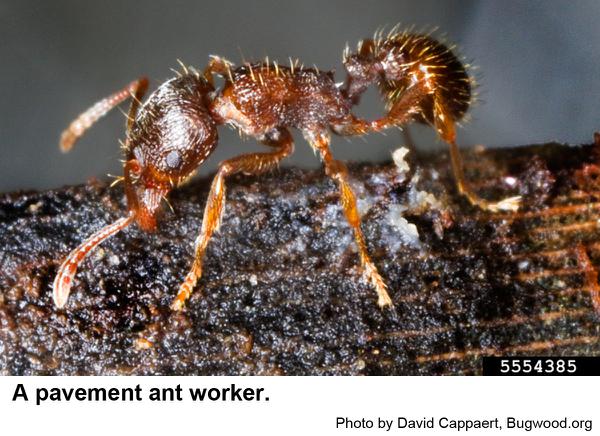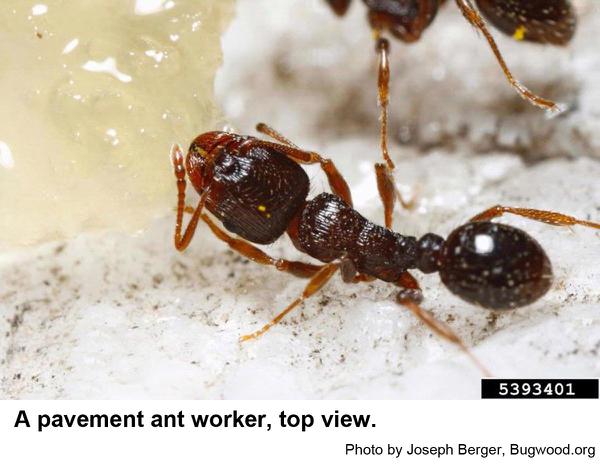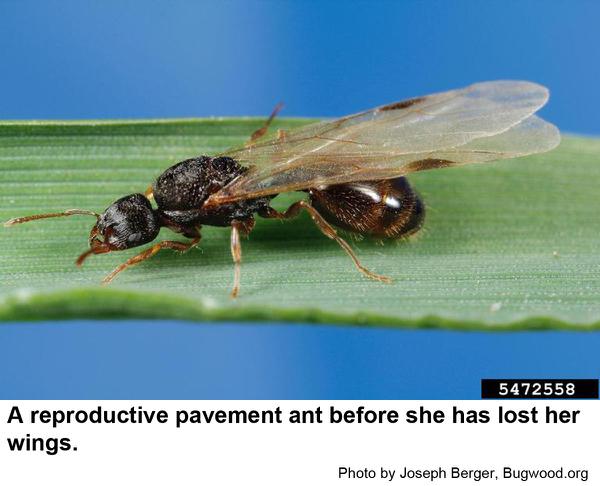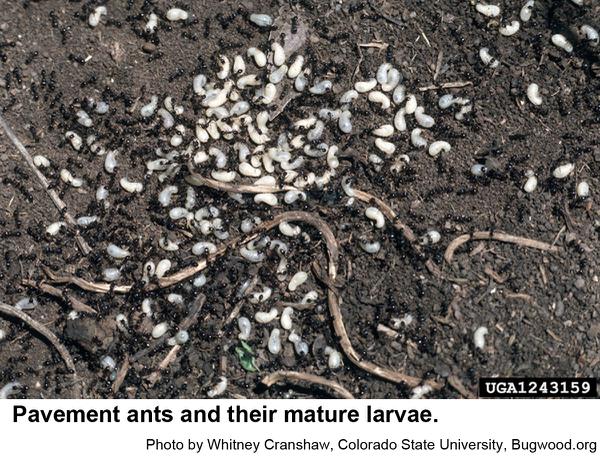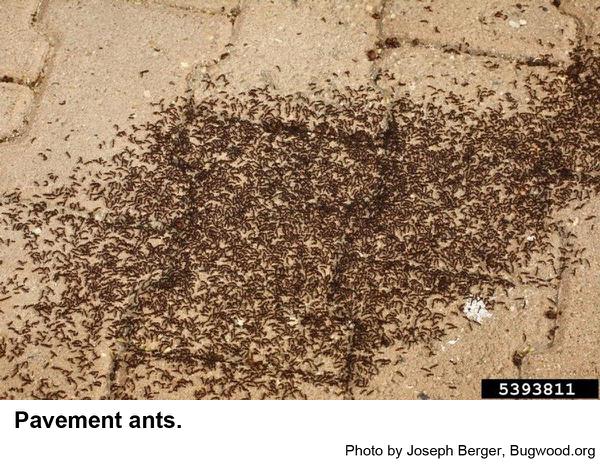Description and Biology
Worker pavement ants, Tetramorium caespitum, are small (about 1/8 to 3/16 inch long), dark brown to nearly black, wingless, insects with prominent, elbowed antennae. On very close inspection, the surface is corrugated with tiny, parallel ridges. This ant has two, distinct, bead-like segments (nodes) between what appears to be the thorax and abdomen. All ants are social insects, but the pavement ant is extremely so. Colonies often have more than 10,000 workers. Workers rear reproductive, winged females and males that leave the colony to form mating swarms in June. These nuptial flights hang in the air in a small cloud. After mating, females alight, shed their wings, and find a suitable nook or cranny in which to found a new colony. She lays eggs that hatch and develop into a first generation of workers about two months later. This "queen" is usually the only ant in a colony that lays eggs although in extremely large colonies two or perhaps more ants become reproductive. Pavement ants are territorial, and may fight neighboring pavement ant colonies to establish a territory about 18 to 20 feet in diameter. Aphids, springtails, mites, and even small butterfly caterpillars sometimes live in pavement ant nests. These ants nest in various microclimates, but they usually prefer open habitats and thrive in human-modified environments.
Food Sources
Pavement ants are general feeders and forage for small arthropods, seeds, pollen, and honeydew excreted by aphids, soft scale insects, and other insects. They sometimes protect aphids and soft scales from parasites and predators and thus contribute to plant damage by these sucking insects.
Residential Recommendations
Pavement ant workers can be nuisance pests when they enter homes and recruit colony members to accessible food or remnants. The best way to prevent ants from entering homes is to locate and block potential entryways and not leave food and crumbs out to attract foraging workers. Ant baits readily attract pavement ants although it may take patience to eliminate a colony this way. Ants indoors may be sponged up with soapy water.
References
- A Guide to House-Invading Ants and Their Control. Alder, P and M. Waldvogel. 2018. Household Pests, NC State Extension Publications.
- Common name: pavement ant, scientific name: Tetramorium caespitum (Linnaeus) (Insecta: Hymenoptera: Formicidae). Vitone, T. and A. Lucky. 2017 (revised). Featured Creatures, Entomology & Nematology, FDACS/DPI, EDIS. Publication Number: EENY-600.
- Key to Identifying Common Household Ants, Quick Management Tips, Pavement ant—Tetramorium caespitum, Subfamily: Myrmicinae. Anonymous. 2017. University of California Agriculture & Natural Resources, UC IPM, Statewide Integrated Pest Management Program.
- Extension Plant Pathology Publications and Factsheets
- Horticultural Science Publications
- North Carolina Agricultural Chemicals Manual
For assistance with a specific problem, contact your local N.C. Cooperative Extension center.
This Factsheet has not been peer reviewed.
Publication date: Feb. 15, 2018
Reviewed/Revised: Nov. 30, 2022
Recommendations for the use of agricultural chemicals are included in this publication as a convenience to the reader. The use of brand names and any mention or listing of commercial products or services in this publication does not imply endorsement by NC State University or N.C. A&T State University nor discrimination against similar products or services not mentioned. Individuals who use agricultural chemicals are responsible for ensuring that the intended use complies with current regulations and conforms to the product label. Be sure to obtain current information about usage regulations and examine a current product label before applying any chemical. For assistance, contact your local N.C. Cooperative Extension county center.
N.C. Cooperative Extension prohibits discrimination and harassment regardless of age, color, disability, family and marital status, gender identity, national origin, political beliefs, race, religion, sex (including pregnancy), sexual orientation and veteran status.

